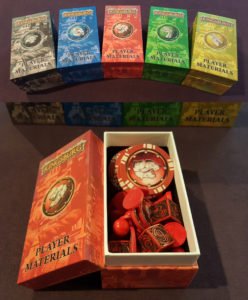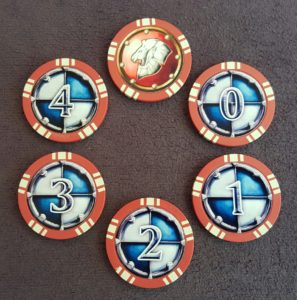I was browsing Instagram last month and stumbled across a custom Jaipur box made by Luke Matthews (aka pixelartmeeple). Luke does a lot of board game upgrade tutorials, which can be found on his BoardGameGeek list, and we’ll be sharing his Jaipur project in this interview.
To Play Is Human: How did you get started with tabletop game and accessories crafting?
Luke Matthews: I’ve always done little things like paint miniatures and laminate game components. A few years ago I discovered foam core, and dove really deep into building foam core inserts for my games. After a while, I wanted to branch out and try different materials like chipboard, the same stuff game boxes are made of. I started with a chipboard insert for Agricola as a way to organize sleeved cards in the box.
This part of the hobby really took off for me when I started building boxes from scratch. The first boxes I built were the resource boxes for my copy of Le Havre. I wanted some sort of custom storage that would fit directly on the board and I couldn’t find any plans for something that looked right to me, so I just made them myself. I taught myself how to do graphics wraps like you see on professional boxes, and it all grew from that project.
TPIH: Tell me a bit about the custom Jaipur components that you made. How did the project come about, what was the process, what kinds of tools/supplies did you use?
Luke: The first card box I ever built was a custom box for Guillotine. The retail box for Guillotine is pretty terrible, and I wanted something both more robust and with a better footprint. Once that box was built, I decided to make custom boxes for all my small card games in a standard size, because it’s always sort of irritated me that there’s no standard size for small box games, and Tetris-ing them onto shelves is always a chore.
Jaipur came about as part of that project, but I knew I wanted to do more with it. I’d made custom poker chip Soldier Tokens for Kingsburg, and wanted to apply that process to upgrading the chips in Jaipur. Once I’d done that, I knew the custom box I built would need storage space for them, so I designed the chip rack to hold them. And somehow managed to get it all to fit together.
For tools, it’s all pretty straightforward: the box is built out of medium-weight chipboard, the graphics wrap is linen paper, and the tools to build it are nothing more than a metal ruler, and XActo knife, spray adhesive, and some Alene’s Tacky Glue. Probably the biggest “expensive” tool is my printer. It’s an older Canon Pro 9000 Mk II large-format photo inkjet printer. And even that only cost me $100.
TPIH: What does your work space look like and what tools do you always have nearby?
Luke: To be honest, I don’t know yet! I moved at the end of last year, and spent the last 6 months or so remodeling a good portion of the new house, and in that time I’ve never really had a chance to set up my new workspace. The last one consisted of a tall craft desk, my computer desk, a set of shelves for supplies, and a long table where I housed my printers. I like having a tall desk for crafting, because I spend a lot of time standing while I’m cutting parts for boxes and upgrades.
The aforementioned tools are always on-hand. I also always have a pile of raw materials: chipboard, linen paper, inkjet cartridges, glue, and the like. I do have a lot of specialized tools, as well, like corner-rounders and circle punches for doing little finishing touches on projects. Oh, and a bone folder. Those things are great for getting graphics wraps to adhere to boxes and making sure the corners are tight.
I begin setting up my new space this weekend, and it’ll look quite a bit different. My craft desk will pull double-duty as a filming studio space, because I’m going to start filming video tutorials and component reviews for a new YouTube channel I’m starting up. Sorry I don’t have any pictures, but I’ll certainly post them to Twitter and Instagram as soon as the space is ready.
TPIH: What do you enjoy about tabletop crafting?
Luke: The stuff I do is all very functional. That’s really what keeps me going with it. Yeah, the aesthetic upgrades are definitely a bonus, but when I’m building boxes they’re intended to be a marriage of form and function. My custom bit boxes help with the storage and setup for my games. My custom card boxes are standardized to fit well on my shelves, save me a little space, and make games easier to find and set up. It’s these functional touches that make me want to keep doing it, because it enhances the gaming experience for me and my game group.
Even the little aesthetic upgrades I do, like custom poker chips or mounting cardstock player boards, are things that enhance gameplay when I pull out a game. And anything that makes gaming more fun is worth doing.
TPIH: What are some other games that you would like to create custom components for in the future?
Luke: I have a very long list. I’ve made over 40 custom boxes at this point, mounted cardstock boards in a bunch of games, and made custom bit boxes for several games. And even after all those projects, I still have card games I need to make custom boxes for, and I’ve got a whole list of projects I plan to do for my upcoming YouTube videos. I plan on mounting the player boards for Castles of Burgundy, Heaven & Ale, and more, I’ve got custom boxes planned for The Game, Skyjo, and several others, and I’m going to make poker chip currency for Power Grid.
One of the recurring projects I want to do are full-fledged deluxe game upgrades. I did a DIY “Deluxe Edition” of one of my favorite games, Kingsburg, a while back, and I’d like to give more of my games that same treatment. Those kinds of projects are really fun for me, and I think others would really enjoy seeing the process and the end result.
TPIH: Poker chip currency for Power Grid is such a great idea!! I love the game, but its currency COULD use an upgrade.
TPIH: What advice would you give to someone thinking about getting into tabletop crafting?
Luke: You really have to enjoy the actual crafting part to make it worthwhile. If your impetus for crafting is the end result, but you don’t actually enjoy the process, then it’s going to feel like a chore to you. Not only will that have a direct effect on the quality of your end result, but it can actually suck the fun out of the actual games you’re crafting for. You gotta love the work.
TPIH: Are there any specific resources you’d direct new crafters to?
Not to be too self-promote-y, but I hope people will see my tutorials as a resource! My whole intention behind all of this is to teach people how to replicate the things I make. Right now, I have a GeekList on BGG that collects all the tutorials I’ve written so far. But aside from my own tutorials, one of the best resources I’ve found is the DIY forum on BoardGameGeek. Not only is it a great place to get advice and read about other peoples’ projects, but there’s a stickied post there with links to damned near any resource you could imagine when it comes to crafting anything from cards or tokens all the way up to custom gaming tables.
TPIH: What are your current favorites in the following categories:
- Game: I don’t have a specific favorite game, but Kingsburg, Troyes, Concordia, Grand Austria Hotel, and Five Tribes are probably my top five, with a lot of other Euros always hovering around those top spots.
- Designer: I have quite a few Uwe Rosenberg games, but I think my favorites Daniele Tascini and Simone Luciani. Council of 4, Tzok’in, Grand Austria Hotel, and the upcoming Teotihuacan: City of Gods… yeah, they’re really good. Xavier Georges is another of my favorites. Troyes and Carson City are both so, so good.
- Theme: I’m not sure I have a favorite theme, as long as it’s well executed and the artwork is appealing. For example, I’m a little tired of “historical Europe” as a setting, but the artwork in Coimbra is so unique and beautiful that it makes up for the tiresome theme.
- Mechanic: Dice-Placement and Dice-Drafting. There’s something really intriguing about combining the worker placement mechanism with the need to mitigate die rolls. Kingsburg, The Voyages of Marco Polo, and Alien Frontiers are all really great examples. Picking your actions by drafting from a pool of dice is a really exciting way to keep a game interesting. Aside from the aforementioned Grand Austria Hotel and Troyes, some of my favorite dice drafting games are Sagrada, Panamax, and Pulsar 2849.
- Game Artist/Sculptor: My three favorite artists working in board games today are Mihajlo Dimitrievski (Raiders of the North Sea, Valeria: Card Kingdoms), Kwanchai Moriya (Dinosaur Island, Capital Lux), and Beth Sobel (WOW the new version of Arboretum is beautiful).
TPIH: Solid choices all around! I, too, favor the artists you mentioned. Dice placement and drafting is definitely an interesting mechanism. I love playing Sagrada. I also really enjoy Quantum. Dice Forge is also fun with its dice building process.
Thank you so much for sharing this project with us, Luke!
CALL FOR SUBMISSIONS
Do you have a tabletop gaming project that you’ve created? Contact me with some information and photos. No project is too big/small — as long as you made it yourself and you use it when you game, it is eligible for submission! I would love to see projects for board game upgrades and accessories, RPGs, miniatures (I would love to see mini paint jobs!), terrain, dice towers, custom playmats, custom dice, or anything else you have made.





























